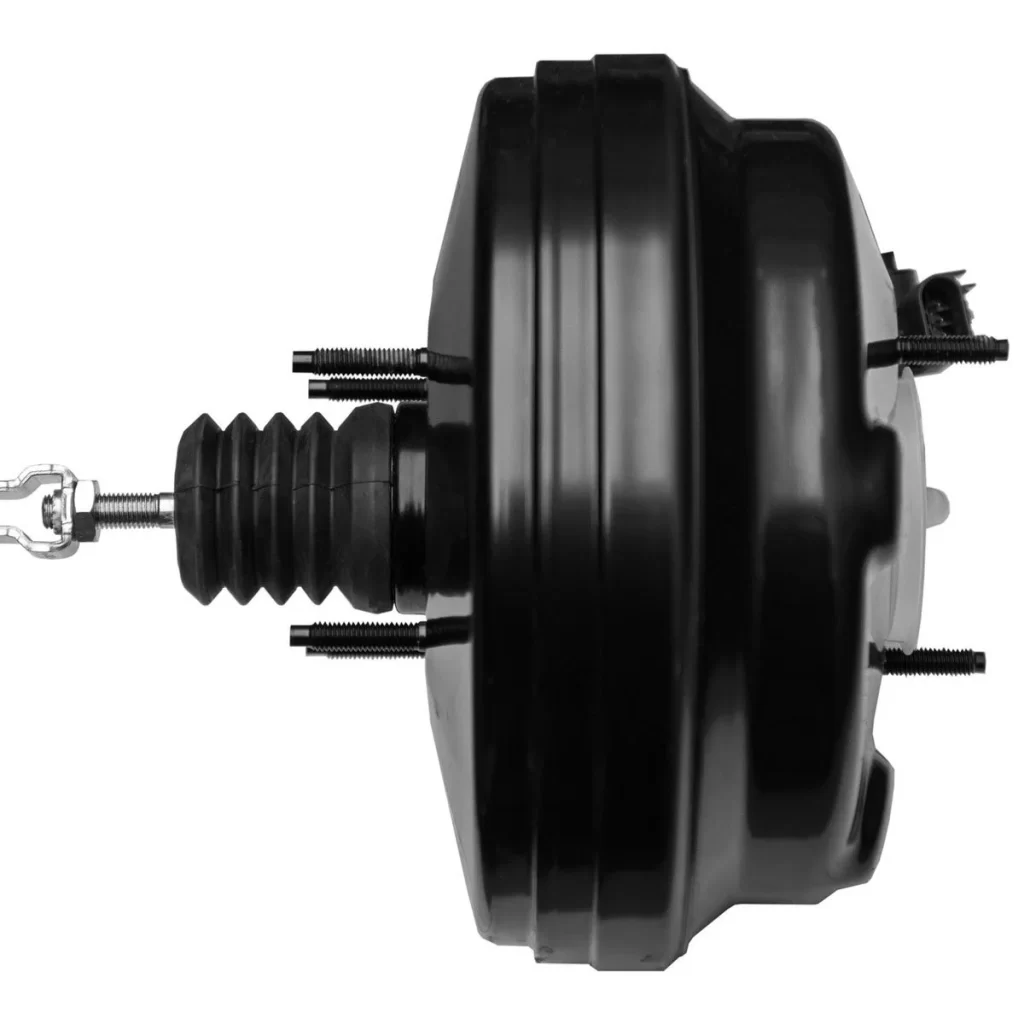The brake booster, often called the power brake booster or vacuum servo, is a critical component that enhances safety and comfort in nearly all modern vehicles. Its primary function is to amplify the driver’s force on the brake pedal, ensuring that even a light touch generates enough hydraulic pressure to quickly stop a heavy vehicle. Without it, stopping a car would require excessive physical effort, drastically increasing stopping distance and driver fatigue.
How the Power Brake Booster Works: Force Amplification
The brake booster is a large, black, circular canister situated between the brake pedal and the master cylinder. Its operation relies on creating a pressure differential to multiply the input force.
| Step | Action by Driver/System | Technical Process (Force Multiplication) |
| 1. Rest State | Brake pedal is released. | Vacuum is maintained equally on both sides (front and rear). |
| 2. Engagement | Driver presses the brake pedal. | The internal control valve allows atmospheric pressure (high pressure) into the rear chamber while the front chamber maintains low vacuum pressure. |
| 3. Boosting | The force difference is created. | The high atmospheric pressure pushes the diaphragm forward toward the master cylinder, multiplying the driver’s initial foot force by a factor of 2x to 4x (200-300 lbs of additional force). |
| 4. Stopping | Amplified force is transferred. | This multiplied force is transferred to the master cylinder. which converts it into the necessary hydraulic pressure to activate the calipers and stop the vehicle. |
Adapting to Modern Engines
The design of the brake booster system must adapt to the type of engine in the vehicle, as not all engines produce the required vacuum power. The evolution of vehicle technology, especially with the rise of Electric Vehicles (EVs), has introduced new, highly efficient booster types.
1. Vacuum Brake Booster (Most Common)
- Used In: Most gasoline-powered passenger vehicles.
- Power Source: Relies on the engine’s intake manifold vacuum.
- Note: Vehicles with limited engine vacuum (e.g., diesel or turbocharged engines) must use an auxiliary electric vacuum pump to supply the necessary power assist.
2. Hydraulic Brake Booster (Hydro-Boost)
- Used In: Heavy-duty trucks, high-performance vehicles, and some diesel engines.
- Power Source: Taps into the high-pressure fluid lines of the power steering pump.
- Advantage: Provides consistent, high-power assist even at engine idle or when vacuum is unavailable.
3. Electric Brake Booster (iBooster/Integrated Power Brake)
- Used In: Hybrid (HEV), Electric (EV), and advanced gasoline vehicles (for integration with ADAS).
- Power Source: Uses an electric motor and sophisticated sensors instead of vacuum or hydraulics.
- Key Role in EVs: Essential in electric cars which lack a combustion engine to create vacuum. The electric booster is more energy-efficient and integrates seamlessly with Regenerative Braking systems and modern safety features like ADAS.
Critical Functions in Vehicle Safety and Performance
The power brake booster is fundamental to modern vehicle safety and driver experience:
| Safety/Performance Factor | Brake Booster Contribution |
| Reduced Stopping Distance | Allows the driver to apply maximum stopping force almost instantly, which is vital in emergency braking situations. |
| Integration with ABS/ADAS | The fast, precise force multiplication supports the rapid, modulated pressure cycling required by Anti-lock Braking Systems (ABS), Electronic Stability Control (ESC), and Brake Assist (BAS) systems. |
| Driver Comfort | Drastically reduces the physical effort (up to 70% or more) required to depress the pedal, minimizing fatigue during long commutes or heavy traffic. |
| Pedal Feel and Response | Provides a light, responsive pedal, making braking predictable and comfortable, unlike manual braking systems which feel “heavy.” |
| Backup Functionality | The system is designed to retain enough vacuum/assist for at least one or two full brake applications even if the engine stalls. |
Recognizing a Faulty Brake Booster
A malfunctioning brake booster compromises vehicle safety. Key symptoms of a failing vacuum booster include:
Increased Braking Distance: When the brake booster starts to fail, the vehicle takes noticeably longer to stop. As a result, the driver must apply more pressure to the brake pedal to achieve the same stopping force. In some cases, this can become dangerous, especially if quick braking is needed in an emergency. Therefore, any increase in braking distance should be taken seriously and inspected by a qualified technician immediately.



